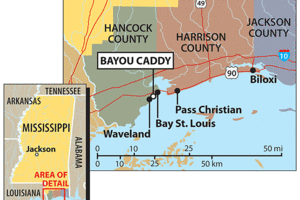At U.S. Army Corps, shift of mission hasn't come easily
Its intent is to become America's coastal policy innovator, but its reputation as 'Congress's general contractor' is proving hard to shake.

Rich Clabaugh
BAY ST. LOUIS, Miss.
The US Army Corps of Engineers can move rivers and shape beaches, but can it change the course of its own legacy?
After Corps-built levees failed under duress from hurricane Katrina, the bureaucracy of 35,000 military engineers, hydrologists, and economists has been trying to do just that.
For an agency that likes to brag that it's older than the US – it was created by the Continental Congress in 1775 to build fortifications at Bunker Hill – transforming itself from "Congress's general contractor" into America's coastal policy leader is no small challenge.
The Army Corps' internal "Actions for Change" tenets basically demand that the agency do less of Congress members' bidding and do more to lead the way to an innovative US coastal policy.
"Fundamental to the plan [is] the acknowledgment that a change in culture within the Corps will have to take place if the tenets are to be realized," writes Gary House, senior Actions for Change manager, in a recent interagency "Engineer Update."
Whether the Corps changes how projects are designed and funded will ultimately determine whether the reforms take hold. Now required to work project by project, the Corps is about $2.5 billion short of what's needed to fully bolster the coast with levees and seawalls and to rebuild wetlands, says Mike Parker, who headed the Army Corps before resigning in 2002 over a budget conflict with the White House.
"There's an old saying in the Corps: 'We may not be fast, but at least we're expensive,' " he says. "The fact is there are a lot of things the Corps knows need to be done and would like to do, but Congress is not funding the money ... to do it."
Critics say lawmakers' practice of earmarking funds for pet projects has created a climate in which the Corps is more likely to be punished than praised for questioning a project's costs or benefits.
"You have a very compliant government entity that makes no judgments about anything," says Ronald Utt, a policy analyst at the conservative Heritage Foundation in Washington. "They have their own internal cost-benefit analysis, but the proclivity toward earmarking over the last 10 to 15 years makes a complete mockery out of that process."
In Louisiana, the Corps aims to do more than rebuild New Orleans' levees. Most critically, many policymakers want it to stop trying to control nature and work with it instead. One proposal would create artificial "distributaries" along the Mississippi River to allow silting during heavy floods to reach the delta, propping up wetlands that can help reduce hurricane damage, says oceanographer Robert Twilley at Louisiana State University in Baton Rouge.
"The biggest thing you have to change is the culture of the institution [so that] it factors in environmental sustainability as part of the mandate," he says.
That's starting to happen, some observers say.
In Mississippi, the Corps will start next month on a $107 million project to build a seawall at Bay St. Louis, build back parts of the Gulf Islands National Seashore destroyed in hurricane Camille in 1969, and reopen natural sluiceways to feed Jackson Marsh in Hancock County, which will help absorb storm surges. That money will get the coast back to its pre-Katrina defenses, says Susan Rees of the Corps' Mississippi Coastal Improvement Program. The next stage would improve the state's defenses, but it's not yet funded.
"The Corps has to balance a lot of different views, and it's a constant," says Mr. Parker, the former Corps chief. "But I think we will be wiser as time goes on."
